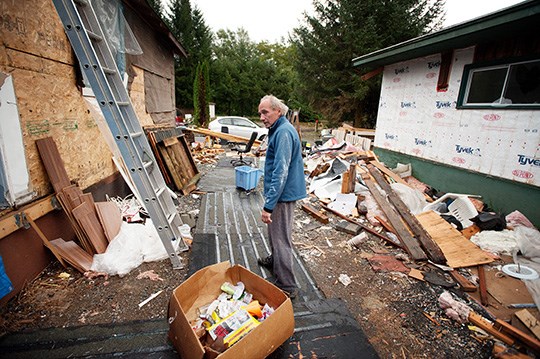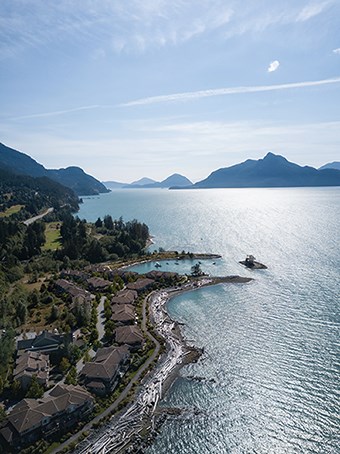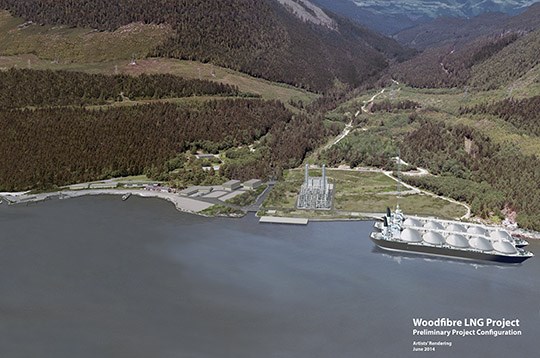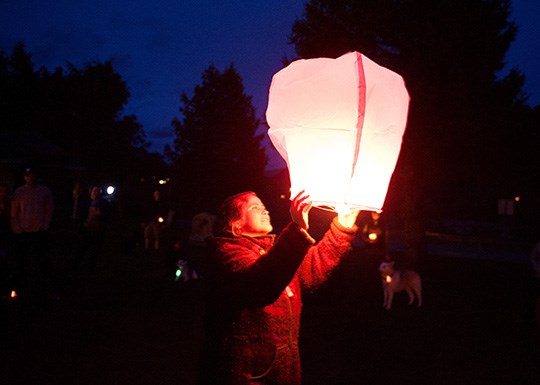This past year has been, if nothing else, a memorable one.
Cost of living, development and rising real estate prices were some of the things that were top of mind for Squamish residents.
Woodfibre LNG passed a major hurdle. The story of how a hunter shot a local therapy dog dead reverberated around the globe.
The Chief has compiled some of the most important events that had wide-reaching effects in town.
What follows below is our Top 11 most important stories of the year.
1. Real estate prices break past the million-dollar mark

For many residents, rising housing prices have been an unwelcome but routine part of life in Squamish.
However, the cost of living in town hit a new milestone this year when the benchmark price of a detached family home reached $1 million in November.
Well, $1,013,000 if you want to be exact.
Even for those who’ve become used to headlines about rising prices, this increase of 105 per cent over the past five years was, at the very least, a noticeable achievement.
As of December, this price beat several communities nearby communities.
This would include Port Coquitlam at $1,000,030; Pitt Meadows at $885,400; Maple Ridge at $815,000 and the Sunshine Coast at $589,000.
The benchmark for Squamish townhouses has been raised as well.
As of November, the benchmark for a Squamish townhouse was about $883,000.
There’s been much complaining about high prices for renters as well.
Comparing numbers compiled by Numbeo, a crowd-sourced data site which measures cost of living, suggests rent prices are similar to Vancouver.
Squamish renters pay an average of $1,200 per month for a one-bedroom apartment located outside downtown, the site says.
On the other hand, it costs an average of $1,399.65 a month to rent a one-bedroom apartment outside Vancouver city centre, according to the site.
While by no means scientific, a quick look at Craigslist on Dec. 14 provides a brief snapshot of the current rental situation.
Searching for Squamish one-bedroom apartments turned up 12 results ranging from $850 to $2,000 per month. This was after junk postings were removed.
2. Pace of development

As Squamish’s population has increased, development appears to have been following a similar pattern.
The number of residents in town has risen to 19,512 in 2016 up from 17,158 in 2011, which accounts for an increase of roughly 13.8 per cent.
In the meantime, the amount of building permits has been following a generally upward trend.
In 2013, there were 171 permits granted.
By 2016, this number reached a peak of 294 granted that year.
As of Nov.15, the most recent date statistics are available, the amount of building permits granted this year has been 231, with an overall value of $117,431,195.
Of those, 124 were to create new buildings from scratch. The rest were for alterations, additions and various other modifications to existing properties.
Permits for single-unit dwellings — in other words, detached one-family homes — were the most popular, accounting for 85 of the granted applications.
The next most popular were single-unit dwellings with a secondary suite attached — 53 of these permits were given.
This is, however, a slightly premature report, so it remains to be seen if the numbers will rise.
Nevertheless, there’s no denying the increasing population has spurred at least some of the development.
With prices in the Lower Mainland escalating, many younger families have given up on trying to own a house in the Vancouver area.
Instead, they’ve been flocking to Squamish, which is close enough to the city to make a daily commute possible, but far enough from Vancouver for housing prices to dip in comparison.
Developers have caught on to the trend, and have been trying to capitalize on what looks to be a booming housing market in town.
Indeed, at any given municipal council meeting this year, the main point of discussion has frequently been development.
3. Number of new businesses popping up

A steady stream of of new businesses have accompanied Squamish’s rising population, with construction showing to be the strongest sector.
The number of new business licences issued each year has hovered between 235 and 388 since 2012.
This year was no exception.
Three-hundred new licences were issued this year, as of Dec. 1.
Overall, it’s an increase from last year, which saw 244 approved.
The trend of business licences appears to following in lockstep with Squamish’s development boom.
District records show that 116 of the new businesses were in the construction sector.
This number far outstripped any other category — the next most prominent sector was professional, scientific and technical services.
There were 23 new licences granted in this division.
Out-of-town business made up a significant amount, as 92 of the 300 new licence holders were not residents of Squamish.
According to District licence renewal statistics, there are 1,785 businesses registered in Squamish.
Four-hundred-seventy-six are owned by people from out of town.
4. Miranda Miller wins world championship

It was a long time coming.
Local rider Miranda Miller has been a renowned figure in the mountain biking scene, especially here in Squamish. But despite her stellar reputation locally, many felt that she hadn’t gained the worldwide recognition she deserved.
That all changed in September when Miller managed to win the gold medal in the elite women’s world downhill division at the 2017 UCI Mountain Bike World Championships in Cairns, Australia.
Miller made national headlines, capturing the attention of major organizations like the CBC and The Canadian Press.
It was a big win for Canada.
Miller’s victory signified the first time a Canadian woman won the world championship in the elite female downhilll mountain biking division since 1990, which just so happens to be the year she was born.
And, of course, aside from getting the national spotlight, the Squamish rider captured the hearts and minds of many people here in town.
A hero’s welcome was given to Miller once she was back in Squamish.
On the day of her return, locals gathered at the parking lot of Corsa Cycles, the store where she works.
Blindfolded, Miller was led out of a friend’s truck. Once the covering was removed from her eyes, hundreds of people who had been waiting at the shop rained champagne and praise down on her.
Aside from compliments and drink, Miller was also treated to some artwork.
The side of the Corsa Cycles building was adorned with green, yellow, black, red and blue stripes — the colours given to champions who’ve proven themselves in the Union Cycliste Internationale.
Those colours also found their way onto Miller’s silver Toyota pickup — her father painted them on her truck.
“It’s pretty cool – lots of people here,” said Miller at the time, during the slight pause between hugs from friends and family. “Makes me feel pretty special.”
Also worth an honourable mention is Holden Jones, who competed at the same event.
He claimed third place in the junior men’s cross-country world championship division, taking home Canada’s first medal during those races.
5. Riverside Trailer Park

Former tenants of the Riverside Park are adapting to their new lives outside that land.
Some have found residence locally in the Spiral Mobile Home Park, while others have opted to move out of province.
This past October marked the close of a long, dramatic saga that forced 19 homeowners to move out of Riverside Trailer Park.
When all was said and done, the only things left behind were debris and hollowed-out homes that were scheduled for demolition.
The story of Riverside is a turbulent one.
Former Squamish Nation chief Bill Williams previously ran the park and residents paid pad fees to his representative at the park.
Trailers had been bought and sold in the park since the 1960s.
However, when the Squamish Nation took over management in 2012, it was found that those operations had been done without jurisdiction.
That same year, the Nation sent a letter to tenants in the park. The document stated that Williams had no right to operate the park and that homeowners were trespassing on the land.
On September 2016, the Squamish Nation announced it was closing down a portion of Riverside that was on Seaichem Reserve in a year’s time.
The Nation said outdated water and sewer infrastructure needed to be replaced.
Rental pad fees were waived for one year, and buyouts were offered as an incentive to get people to leave earlier.
Nevertheless, disputes ensued.
This past summer, the Nation filed legal actions in court claiming that the owners of three trailers had not signed agreements to leave by the end of this past September.
The Nation asked the courts to order the tenants out of the park.
Action was dropped against two of the tenants who settled out of court.
The final tenant, Wendy Linton was ordered by Justice T. Mark McEwan to pay the Nation almost $12,000 in back rent and damages to the Nation in the Vancouver court on
Oct. 11.
In the end, everyone given notice moved out of the park.
6. Waterfront Landing passes

The path has been paved for a development that will change Squamish’s landscape in a big way during the coming years.
If everything goes according to plan, between 900 to 1,100 housing units will be constructed on Waterfront Landing.
This will include duplexes, townhouses and apartments. It’s anticipated the developers will also throw in 55 affordable housing and 50 market rental housing units.
The project, spearheaded by Bosa and Kingswood Properties, will be built on 1500 Highway 99.
It’s a proposal that was deliberated in detail by the District council.
One particular point of concern was the pedestrian connectivity to downtown.
During one of its readings on the matter, council placed much emphasis on speeding up the timeline on constructing a pedestrian footbridge that would connect the development to downtown.
It’s now expected that this bridge, which will pass over the Mamquam Blind Channel, will be built before the 215th unit of housing is completed.
About 2,000 square feet of daycare space will be included in the development, and 2.1 hectares of the 21.5-hectare development will be a waterfront public park.
A 30-berth public marina is also part of the plan.
7. Furry Creek

If you looked carefully enough at the background of the scene, as Bob Barker punches Adam Sandler in the hit movie Happy Gilmore, the camera catches a glimpse of Howe Sound.
It’s a view that can only be caught from the vantage point of Furry Creek golf course.
And it’s a view that may be changing dramatically in a few years.
While Sandler may have screamed that “the price is wrong” at Barker, apparently the people running Fine Peace Holdings thought the undisclosed price of the course was right.
Fine Peace, a company based in China, bought the course and the 175 acres surrounding it from the Burrard Group.
In a presentation to the SLRD, Michael Geller, the Vancouver development consultant behind the deal, said that the company would be revamping the golf course.
Furthermore, Fine Peace would likely be proposing about 250 housing units for the area. A marina for local residents and a mixed-use commercial zone were also ideas the company was considering, he said.
There were some concerns from SLRD directors, however.
The possibility of flooding in the area was brought up. Traffic from all the new residents was also a concern, as was affordable housing.
Geller said in response that apartments with structural parking at the bottom could prevent water from seeping into living spaces.
He also said that he hoped to include enough amenities — such as a general store — to keep people from piling onto the highway for basic necessities.
Finally, he also appeared to express openness to discussing the possibility of affordable housing.
As for workers at the course, it appears as if business will go on as usual.
Patricia McDowell, a grounds maintenance worker for Furry Creek, told The Chief at the time of the sale that workers will get to keep their jobs.
8. Woodfibre LNG gets NEB’s approval amidst uncertain economic conditions

Woodfibre’s controversial LNG project passed through a critical hurdle this year, gaining the approval of the National Energy Board.
It was a major win for those who believed the facility would spur local economic development, but a sore point for environmentalists.
After the NEB gave the project the thumbs-up in April, the federal government affirmed its support for the decision in June.
The approval gives Woodfibre a license to export LNG for 40 years, starting from the date the first ship sails from its facility.
A total of 3.34 billion cubic metres of natural gas is allowed to be exported each year — the equivalent of up to 1.3 million Olympic-sized swimming pools worth of material.
Woodfibre was originally granted a 25-year licence in December 2013, but changes to NEB regulations allowed for a maximum export term of 40 years.
When the new regulations were set in motion, the company decided to apply for the new 40-year limit.
However, while Woodfibre has jumped through critical regulatory hoops, the LNG industry has run into uncertain times.
Perhaps the most telling sign of economic turbulence in that industry was the cancellation of the multibillion-dollar Petronas LNG project in Port Edward, B.C.. in August.
The Pacific NorthWest LNG facility, which was estimated by some to cost $11.4 billion, would not be constructed after “a careful and total review of the project amid changes in market conditions,” Petronas said at the time.
This news made waves, as many observers considered the Pacific NorthWest project as a measure of whether or not B.C.’s would find success entering the global LNG market.
Nevertheless, Woodfibre has maintained that its project will be able to weather changing economic conditions.
9. Byrdie Funk gets citizenship

After years of being stateless due to a bizarre bureaucratic anomaly, Squamish resident Byrdie Funk became a Canadian citizen — again.
It was a long time coming, considering that she’s lived in Canada for virtually her entire life.
Funk was born in Mexico but moved to Canada when she was two months old.
However, a little-known law required citizens born outside of Canada between Feb.15, 1977 and April 16, 1981 to reapply for citizenship before their 28th birthday.
Funk wasn’t aware of the rule, so she didn’t reapply in 2008, when she turned that age.
In April 2016, she received a letter from the government informing her that she hadn’t been a citizen since that year.
Since then, it’s been an uphill battle for Funk to regain her citizenship.
But in June this year, Funk received a call from the chief of staff of the federal immigration minister.
Her citizenship had been restored.
So on Canada Day, Funk was able to stand tall during a citizenship ceremony and once again call herself a Canadian.
Funk says that she will keep campaigning on behalf of fellow “lost Canadians” who have had their citizenship taken away because of the reapplication law.
10. Therapy dog killed by hunter

It was a story that sent shockwaves around the world.
While taking a walk through a wooded area in September, Valley Calderoni saw her dog get shot by a hunter who presumably mistook the canine for a wolf.
Calderoni was in shock as she watched Kaoru, a therapy dog that worked with autistic children, stumble a few steps before collapsing.
After The Chief broke the story, that shock reverberated nationwide and quickly spread across the globe.
In the end, the incident was covered by outlets ranging as far and wide as the BBC, The Independent, The New York Post and People magazine, among others.
Many were galvanized by the occasion.
A memorial was held locally shortly after Kaoru’s death, and in the days that followed, funds were donated and a petition was circulated.
Since September, 326 people raised more than $16,100 through a gofundme.com campaign.
The aim was to donate cash that would help train new therapy dogs, assist Calderoni’s dog rehabilitation centre and for a no-hunting campaign.
To date, more than 31,000 people signed a Change.org petition calling on authorities to broaden the no-hunting zone.
As of now, many are awaiting to see if authorities will recommend charges against the hunter.
Calderoni recently told The Chief that conservation officers still haven’t informed her about any potential charges.
11. Oceanfront moves forward

There was some forward movement on the oceanfront development this year.
While no buildings have yet to be constructed on Newport Beach — formerly known as Nexen Beach — fill has been deposited and an access road has been created.
Furthermore, municipal council granted Newport Beach Developments a development permit for a green technology building.
That building’s completion is expected to precede the construction of the residential units that are expected to house 6,500 people.
It’s hoped that the green-tech facility will help draw a university to the land.
Last year, UBC, the District of Squamish, the Squamish Nation, Carbon Engineering and Newport Beach Developments signed a co-operation agreement.
However, as of April this year, developer Michael Hutchison said that Newport was in an “arms race” with three other sites to bring UBC and a technology university to the development.
In June, Hutchison and Mayor Patricia Heintzman travelled to China in an effort to drum up interest in the project.
The delegation from B.C., which included representatives from UBC and Newport Developments, met with representatives from the Southern University of Science and Technology in the city of Shenzhen, in southeastern China.
It was hoped that an agreement could be made on a possible partnership and campus on the oceanfront land.
At the time, the mayor said that things went well, though the talks were still in the preliminary stages.
Before the trip to China, delegates from the Southern University were in Squamish to take a look at the land.
The university’s long-term goal is to expand the school’s reach with six new academic colleges and 26 research centers.



